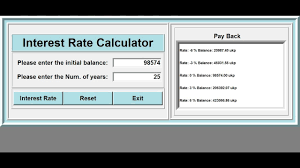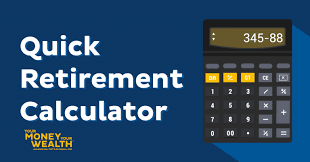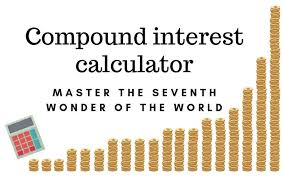Discover the key to successful financial planning with our comprehensive guide, featuring the Annual Interest Rate Calculator (EMI Interest Calculator) and Compound Interest and Simple Interest Formula. These indispensable tools will help you navigate the complex world of loans and investments, empowering you to make well-informed decisions for a secure financial future. Don’t miss out on the opportunity to optimize your financial strategy; explore our guide and take control of your finances today.
Interest Rate Calculator
What is Interest Rate?
In simple terms, interest rate refers to the percentage of a loan that a lender charges a borrower for the use of their money. It is essentially the cost of borrowing money. Interest rates are expressed as an annual percentage rate (APR), which represents the total cost of borrowing money over a year.
How Are Interest Rates Determined?
Interest rates are determined by a variety of factors, including:
Central Bank Policies – Central banks play a crucial role in determining interest rates. They control the supply of money in the economy and use interest rates as a tool to control inflation.
Economic Conditions – Interest rates are influenced by economic conditions such as unemployment rates, GDP growth, and inflation.
Creditworthiness – A borrower’s creditworthiness plays a significant role in determining the interest rate they’ll be charged. A borrower with good credit will generally be offered a lower interest rate than a borrower with poor credit.
How Do Interest Rates Affect the Economy?
Interest rates have a significant impact on the economy. When interest rates are low, borrowing becomes more accessible and less expensive. This stimulates spending and investment, leading to economic growth. However, when interest rates are high, borrowing becomes more challenging and more expensive. This can lead to a slowdown in spending and investment, which can lead to a recession.
How Do Interest Rates Affect Financial Markets?
Interest rates have a direct impact on financial markets. When interest rates rise, bond prices tend to fall, and when interest rates fall, bond prices tend to rise. This is because bond prices are inversely related to interest rates. Additionally, higher interest rates can lead to a stronger currency, while lower interest rates can lead to a weaker currency.
Interest rates play a critical role in the economy and financial markets. They impact borrowing costs, spending, and investment, and are influenced by a variety of factors. Understanding interest rates is essential for anyone who wants to make informed financial decisions.
Simple vs. Compound Interest
What is Simple Interest?
Simple interest is a straightforward interest calculation method that applies a fixed rate of interest to the principal amount of a loan or investment. It is calculated based on the initial investment amount, known as the principal, and the interest rate, which is usually expressed as a percentage.
For example, suppose you borrow $10,000 at an annual interest rate of 5%. In that case, the simple interest calculation would be ($10,000 x 5% = $500). So, after one year, you would owe $10,500 to the lender.
What is Compound Interest?
Compound interest is a more complex interest calculation method that adds the interest earned to the principal amount, resulting in a higher interest payment in subsequent periods. Unlike simple interest, compound interest takes into account the interest earned in the previous period.
For example, suppose you invest $10,000 at an annual interest rate of 5% for five years. In that case, the compound interest calculation would be as follows:
Year 1: $10,000 x 5% = $500 Total Amount at the end of Year 1: $10,500
Year 2: $10,500 x 5% = $525 Total Amount at the end of Year 2: $11,025
Year 3: $11,025 x 5% = $551.25 Total Amount at the end of Year 3: $11,576.25
Year 4: $11,576.25 x 5% = $578.81 Total Amount at the end of Year 4: $12,155.06
Year 5: $12,155.06 x 5% = $607.75 Total Amount at the end of Year 5: $12,762.81
As you can see, compound interest increases over time because the interest earned in each period is added to the principal amount, resulting in a higher interest payment in the subsequent periods.
Simple vs. Compound Interest – Which is Better?
When it comes to choosing between simple and compound interest, it depends on your investment goals and the type of investment you are making. Simple interest is best for short-term investments or loans, while compound interest is better for long-term investments.
In simple interest, the interest payment remains the same throughout the investment period, making it easier to calculate and understand. It is ideal for investments or loans with a shorter duration, such as personal loans or short-term savings accounts.
On the other hand, compound interest provides a higher return on investment in the long run. It is ideal for long-term investments such as retirement savings accounts or investment portfolios.
Compound Interest and Simple Interest Formulas
Interest, a fundamental concept in finance, can significantly impact your savings and investments. Whether you’re earning or paying interest, understanding the formulas behind it is essential. In this article, we’ll unravel the mysteries of compound interest and simple interest, two key types of interest calculations.
Simple Interest Formula
Simple interest is the most straightforward type of interest, typically used for short-term loans and investments. The formula for calculating simple interest is:
I=P⋅R⋅T
- I: The interest earned or paid.
- P: The principal amount (the initial sum of money).
- R: The annual interest rate (expressed as a decimal).
- T: The time (in years) the money is borrowed or invested.
For example, if you invest $5,000 in a savings account with a 4% annual interest rate for 3 years, you can calculate the simple interest as follows:
I = 5,000 \cdot 0.04 \cdot 3 = $600
Your interest earnings would amount to $600 over the 3-year period.
Compound Interest Formula
Compound interest, on the other hand, accounts for interest being added to the principal at regular intervals, allowing your money to grow exponentially over time. The compound interest formula is more complex:
A=P(1+nR)n⋅T−P
- A: The future value of the investment/loan, including interest.
- P: The principal amount.
- R: The annual interest rate (expressed as a decimal).
- n: The number of times interest is compounded per year.
- T: The time (in years) the money is invested or borrowed.
For example, if you invest $5,000 at a 4% annual interest rate compounded annually for 3 years, you can calculate the compound interest as follows:
A = 5,000 \left(1 + \frac{0.04}{1}\right)^{1 \cdot 3} – 5,000 = $6,124.86
The future value of your investment would be approximately $6,124.86 after 3 years.
Key Differences
Frequency of Calculation:
- Simple Interest: Interest is calculated only on the initial principal throughout the specified time period.
- Compound Interest: Interest is calculated periodically and added to the principal, resulting in interest on interest.
Growth Over Time:
- Simple Interest: Provides linear growth, with interest amount remaining constant over time.
- Compound Interest: Offers exponential growth, as interest compounds, leading to larger returns over time.
Usage:
- Simple Interest: Typically used for short-term loans and straightforward investments.
- Compound Interest: Commonly used for long-term investments, savings accounts, and loans with interest that compounds periodically.
In conclusion, understanding the formulas for simple and compound interest is essential for anyone managing finances, investing, or borrowing money. These formulas allow you to calculate how interest impacts your financial decisions and how your money can grow or shrink over time. Whether you’re saving for the future or managing loans, mastering these calculations can empower you to make informed financial choices.
Uncontrollable Economic Factors that Affect Interest Rate
In this article, we will discuss some of the key uncontrollable economic factors that impact interest rates.
- Inflation
Inflation is the rate at which prices for goods and services increase over time. As inflation rises, the purchasing power of the dollar decreases, making it more expensive to borrow money. Higher inflation can lead to higher interest rates as lenders need to charge more to offset the decrease in the value of the money they lend.
- Economic Growth
Economic growth is another significant factor that affects interest rates. When the economy is growing, businesses are expanding, and consumers are spending more money. This leads to an increase in demand for credit, which can drive up interest rates. Conversely, when the economy is stagnant or in a recession, demand for credit decreases, which can lead to lower interest rates.
- Government Policies
Government policies, particularly those related to monetary and fiscal policies, can also impact interest rates. The Federal Reserve, for example, can increase or decrease the benchmark interest rate, which can influence the interest rates of other financial products. Fiscal policies, such as tax cuts or government spending, can also impact interest rates by affecting the overall health of the economy.
- International Events
International events, such as political upheaval, economic instability in other countries, or changes in global financial markets, can also impact interest rates. These events can cause investors to shift their investments, leading to changes in the supply and demand for credit, which can affect interest rates.
- Supply and Demand
Finally, supply and demand play a critical role in interest rates. When demand for credit is high, lenders can charge higher interest rates. When supply exceeds demand, lenders may lower interest rates to attract borrowers. Factors such as population growth, changes in demographics, and shifts in consumer behavior can all impact the supply and demand for credit.
In conclusion, interest rates are impacted by a variety of uncontrollable economic factors, including inflation, economic growth, government policies, international events, and supply and demand. These factors can cause interest rates to rise or fall, affecting everything from mortgage rates to credit card interest rates.
Controllable Factors that Determine Interest Rate
We will discuss the controllable factors that determine interest rates.
- Credit Score
One of the most significant controllable factors that determine interest rates is an individual’s credit score. Credit scores are determined by a person’s credit history, including payment history, debt-to-income ratio, and credit utilization. A higher credit score indicates that a borrower is more likely to repay their debt, making them a lower risk to lenders. As a result, borrowers with higher credit scores may be able to secure lower interest rates.
- Loan Amount and Duration
The loan amount and duration are other factors that can impact interest rates. Larger loans may come with higher interest rates because they represent a higher risk to lenders. Similarly, longer loan durations may come with higher interest rate calculator as they give borrowers more time to default on their loans. Conversely, shorter loan durations may come with lower interest rates as they represent less risk to lenders.
- Collateral
Collateral is another controllable factor that can affect interest rates. Collateral refers to assets that a borrower pledges as security for a loan. If a borrower defaults on their loan, the lender can seize the collateral to recoup their losses. Borrowers who offer collateral may be able to secure lower interest rates as they represent a lower risk to lenders.
- Payment Frequency and Method
The frequency and method of loan payments can also impact interest rates. Borrowers who make payments more frequently, such as bi-weekly instead of monthly, may be able to pay off their loans faster and reduce the amount of interest they pay overall. Additionally, borrowers who opt for automatic payments may be able to secure lower interest rates as it reduces the risk of missed or late payments.
- Market Competition
Finally, market competition can also impact interest rates. Borrowers who shop around and compare interest rates from different lenders may be able to find better deals. This is because lenders may offer lower interest rates to attract borrowers and stay competitive in the market.
How to Receive Better Interest Rates
Here are some tips on how to receive better interest rates.
- Improve your credit score
Your credit score is one of the most important factors that lenders consider when determining your interest rate. A higher credit score shows that you’re a responsible borrower and less of a risk, which means lenders will be more likely to offer you better rates. To improve your credit score, pay your bills on time, keep your credit card balances low, and avoid opening too many new accounts at once.
- Shop around
Don’t settle for the first interest rate you’re offered. Shop around and compare rates from different lenders to find the best deal. This can include banks, credit unions, and online lenders. Be sure to look at both the interest rate and any fees or penalties that may be associated with the loan.
- Consider a secured loan
If you have collateral, such as a car or home, you may be able to get a lower interest rate by taking out a secured loan. This type of loan is backed by your collateral, which makes it less risky for the lender. Just be aware that if you default on the loan, you could lose your collateral.
- Refinance your loans
If you already have loans, such as a mortgage or car loan, consider refinancing to get a better interest rate. This involves taking out a new loan to pay off your existing loan(s). If you have a good credit score and a stable income, you may be able to qualify for a lower interest rate and save money in the long run.
- Build a relationship with your lender
Building a relationship with your lender can help you get better interest rates in the future. This could involve opening a checking or savings account with the lender or using their credit card. If you have a good payment history with the lender, they may be more willing to offer you better rates in the future.
How to calculate interest rate on a loan or on a deposit?
Here are some tips on how to calculate interest rates on loans and deposits.
Calculating Interest Rates on Loans
- Determine the loan amount
The loan amount is the total amount of money you borrow from a lender. This could be a personal loan, a car loan, or a mortgage. To calculate the interest rate on the loan, you first need to determine the loan amount.
- Determine the term of the loan
The term of the loan is the length of time you have to pay back the loan. This could be a few months, a few years, or even several decades. To calculate the interest rate on the loan, you need to know the term of the loan.
- Determine the interest rate
The interest rate is the percentage of the loan amount that the lender charges as interest. This can vary depending on the lender, the type of loan, and other factors. To calculate the interest rate on the loan, you need to know the interest rate.
- Use an online calculator
Once you have all of the necessary information, you can use an online loan calculator to calculate the interest rate on the loan. This will give you an estimate of the total amount you will pay back over the term of the loan, including the principal amount and the interest.
Understanding the Annual Interest Rate Calculator
Interest rates are at the heart of any financial transaction, whether it’s taking out a loan, making an investment, or opening a savings account. The annual interest rate, often abbreviated as APR (Annual Percentage Rate), is a critical factor in determining the cost or return on these financial endeavors. In this article, we’ll delve into the world of the Annual Interest Rate Calculator, helping you demystify this essential financial tool.
The Basics of the Annual Interest Rate
The annual interest rate is a percentage that represents the cost of borrowing money (in the case of loans) or the return on investment (in the case of savings and investments) over the course of a year. This rate accounts for the interest charges or earnings that accrue annually.
Understanding the Annual Interest Rate Calculator
The Annual Interest Rate Calculator is a powerful tool that allows you to:
Determine Loan Costs: When borrowing money, you can use the calculator to estimate the total cost of a loan by inputting the loan amount, loan term, and annual interest rate. It provides insights into the interest you’ll pay over the loan’s duration.
Evaluate Investment Returns: For investments or savings accounts, the calculator helps you project how your initial investment will grow over time. You’ll input the principal amount, annual interest rate, and investment period to forecast future earnings.
Compare Financial Products: By using the calculator, you can compare the annual interest rates offered by different lenders or investment opportunities. This enables you to make informed decisions and choose the most favorable option.
Using the Annual Interest Rate Calculator
Here’s how to use this handy tool effectively:
Input Principal Amount: Start by entering the principal amount, which is the initial sum of money you’re borrowing or investing. This serves as the foundation for all calculations.
Specify Annual Interest Rate: Next, input the annual interest rate applicable to your financial transaction. Ensure that you enter it as a decimal (e.g., 5% as 0.05).
Set the Investment Period or Loan Term: Depending on your situation, specify the investment period (in years) or loan term (in months or years). This parameter determines how long your money will be subject to the given annual interest rate.
Review the Results: The calculator swiftly computes the results, displaying either the total cost of the loan (for borrowing scenarios) or the future value of your investment (for savings and investments). You’ll gain insights into your financial outcome based on the provided parameters.
Benefits of the Annual Interest Rate Calculator
Financial Planning: It aids in precise financial planning, helping you understand the implications of interest rates on your financial decisions.
Comparison Tool: You can compare different financial products or investment opportunities to determine which one aligns best with your goals.
Informed Decision-Making: Armed with accurate calculations, you can make informed choices about loans, investments, and savings strategies.

Frequently Asked Questions
What is simple interest, and how does it differ from compound interest?
Simple Interest: Simple interest is calculated only on the initial principal amount throughout the specified time period. It does not consider interest earned or paid on previously earned interest.
Compound Interest: Compound interest accounts for interest being added to the principal at regular intervals. This results in interest being calculated on both the initial principal and any previously earned interest. It leads to exponential growth over time.
What is the formula for calculating simple interest?
The formula for calculating simple interest is:
I=P⋅R⋅T
Where:
- I is the interest earned or paid.
- P is the principal amount (the initial sum of money).
- R is the annual interest rate (expressed as a decimal).
- T is the time (in years) the money is borrowed or invested.
What is the formula for calculating compound interest?
The formula for calculating compound interest is more complex and is given by:
A=P(1+nR)n⋅T−P
Where:
- A is the future value of the investment/loan, including interest.
- P is the principal amount.
- R is the annual interest rate (expressed as a decimal).
- n is the number of times interest is compounded per year.
- T is the time (in years) the money is invested or borrowed.
How can I use the Annual Interest Rate Calculator?
The Annual Interest Rate Calculator helps you determine the annual interest rate’s impact on loans, investments, and savings. To use it, input the principal amount, annual interest rate (as a decimal), and the investment period or loan term. The calculator provides insights into loan costs or investment returns.
Why is understanding these interest formulas important?
Understanding simple and compound interest formulas is crucial for managing finances effectively. It empowers individuals to make informed decisions regarding loans, investments, and savings. By comprehending the formulas, you can calculate costs, returns, and potential earnings accurately, ensuring that your financial choices align with your goals.
Can I use the Annual Interest Rate Calculator for both loans and investments?
Yes, the Annual Interest Rate Calculator is versatile and can be used for both loans and investments. It helps you assess the impact of annual interest rates on your financial decisions, whether you’re borrowing money or looking to grow your savings and investments.
Is the calculator suitable for short-term and long-term financial calculations?
Absolutely. The calculator can be employed for short-term and long-term financial planning. Whether you’re dealing with a one-year investment or a multi-year mortgage, it provides accurate results for various time frames.
Can I compare different financial products using the Annual Interest Rate Calculator?
Yes, the calculator serves as a valuable comparison tool. It allows you to input the annual interest rates associated with different financial products and assess their impact on your finances. This enables you to make informed decisions and select the most favorable option for your needs.
Conclusion
The Annual Interest Rate Calculator is an indispensable tool for anyone seeking clarity in their financial transactions. By mastering its use, you can navigate loans, investments, and savings with confidence, ensuring that you’re making decisions that align with your financial goals and aspirations.
Legal Notices and Disclaimer
All Information contained in and produced by the ModernCalculators.com is provided for educational purposes only. This information should not be used for any Financial planning etc. Take the help from Financial experts for any Finace related Topics. This Website will not be responsible for any Financial loss etc.





